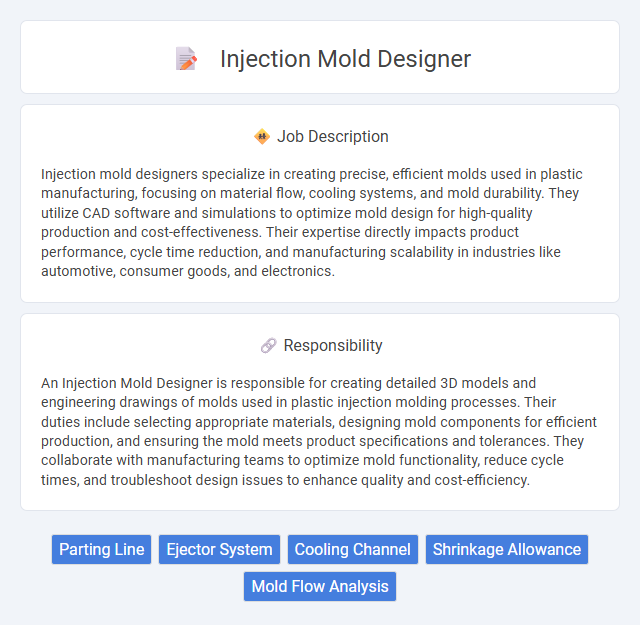
Injection mold designers specialize in creating precise, efficient molds used in plastic manufacturing, focusing on material flow, cooling systems, and mold durability. They utilize CAD software and simulations to optimize mold design for high-quality production and cost-effectiveness. Their expertise directly impacts product performance, cycle time reduction, and manufacturing scalability in industries like automotive, consumer goods, and electronics.
Injection mold designer roles likely appeal to individuals with strong analytical skills and attention to detail, as the job demands precision in creating molds for manufacturing. Those who thrive in structured environments and enjoy solving complex engineering problems may find this career highly suitable. Candidates lacking patience for iterative design processes or discomfort with technical software might face challenges adapting to the role.
Qualification
Injection mold designers require strong proficiency in CAD software such as SolidWorks or AutoCAD, along with a deep understanding of plastic materials and molding processes. Expertise in creating detailed mold designs, including core and cavity layouts, cooling channels, and draft angles, is essential for ensuring precision and manufacturability. Strong problem-solving skills and knowledge of manufacturing constraints and quality standards like ISO 9001 enhance the designer's ability to deliver efficient, cost-effective mold solutions.
Responsibility
An Injection Mold Designer is responsible for creating detailed 3D models and engineering drawings of molds used in plastic injection molding processes. Their duties include selecting appropriate materials, designing mold components for efficient production, and ensuring the mold meets product specifications and tolerances. They collaborate with manufacturing teams to optimize mold functionality, reduce cycle times, and troubleshoot design issues to enhance quality and cost-efficiency.
Benefit
Injection mold designers likely experience numerous benefits, including opportunities for creative problem-solving and innovation in product development. The role may offer competitive salaries and job stability due to high demand in manufacturing industries. Working in this field probably enhances technical skills in CAD software and material science, which can improve career advancement prospects.
Challenge
Injection mold designer roles likely present challenges in balancing complex technical specifications with production efficiency. Designers probably face pressure to innovate while ensuring molds are cost-effective and durable under high-volume manufacturing conditions. Overcoming material constraints and precision requirements may require advanced problem-solving skills and continuous adaptation to new technologies.
Career Advancement
Injection mold designers can advance their careers by gaining expertise in CAD software, materials science, and manufacturing processes to improve design efficiency and product quality. Mastery of simulation tools and collaboration skills often leads to senior designer or project management roles within manufacturing companies. Pursuing certifications such as Certified Mold Designer (CMD) enhances credibility and opens opportunities in specialized industries like automotive and aerospace.
Key Terms
Parting Line
Injection mold designers specialize in creating precise parting lines that ensure seamless mold separation and optimal product quality. The parting line location directly impacts material flow, cosmetic appearance, and ease of mold release, requiring thorough analysis of product geometry and draft angles. Advanced CAD software and mold flow simulation tools enable designers to optimize parting line placement, reducing defects and improving cycle times.
Ejector System
An Injection Mold Designer specializing in the ejector system is responsible for developing precise mechanisms that effectively remove molded parts from the mold cavity without damage. Expertise in designing ejector pins, plates, sleeves, and ejector return systems ensures optimal cycle times and improved part quality. Proficiency in CAD software and knowledge of material behavior during ejection enhances the reliability and efficiency of the injection molding process.
Cooling Channel
Injection mold designers specialize in creating efficient cooling channel layouts to optimize cycle times and part quality. Properly designed cooling channels reduce thermal distortion and improve dimensional accuracy by maintaining uniform mold temperature. Advanced simulation tools are employed to model heat transfer and fluid flow, ensuring enhanced cooling performance and production efficiency.
Shrinkage Allowance
Injection mold designers calculate shrinkage allowance to compensate for material contraction during cooling, ensuring final parts meet precise dimensional specifications. Accurate shrinkage rates vary by resin type, mold temperature, and part geometry, requiring designers to integrate material science data with CAD modeling tools. Failure to apply correct shrinkage allowance can lead to defects such as warping, dimensional inaccuracies, and assembly issues in molded components.
Mold Flow Analysis
Injection mold designers specializing in Mold Flow Analysis optimize the plastic injection process by simulating material flow within the mold to predict and prevent defects such as warping, air traps, and sink marks. Proficient use of Mold Flow software tools enhances part quality, reduces cycle times, and lowers manufacturing costs by ensuring balanced filling and proper cooling channel design. Expertise in interpreting simulation data drives design modifications that improve mold performance and increase production efficiency.
 kuljobs.com
kuljobs.com